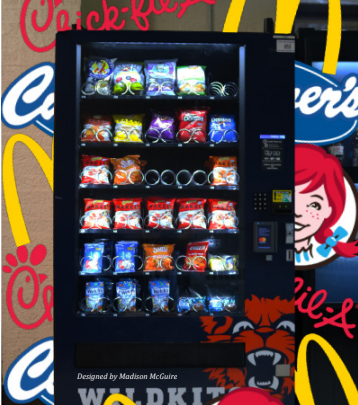Students need to fast-food culture

September 27, 2019
We live in a world dominated by fast culture. Almost anything we want we can get with the click of a button, and while this fast-paced world we live in can sometimes be extremely useful, other times it can be more harmful. One scenario in which that is possible is when it comes to food.
This is because when getting food from fast chains, the main intent is to get the food quickly to their customers. And when one of the sole intents is speed, problems can occur.
When comparing fast-food meals to things you can cook at home there is a 421 calorie and 30 grams of fat difference. For that specific example, researchers only looked at one McDonald’s Big Mac rather than adding fries and a soda, which many of us can’t seem to resist.
As a way for more people to buy their savory and irresistible items, McDonald’s prices the Big Mac lower than some of their healthier options. Right now the Big Mac is priced at $3.99, while their salads are priced at $4.79 and their wraps are priced at $4.39.
One of the main reasons for fast food companies charge more for their healthier options is due to how expensive it is to grow fruits and vegetables compared to grains and corn syrup, which many junk foods are made of. According to an article by The Washington Post, one serving size of broccoli costs 14 cents and one serving size of blackberries costs 74 cents to produce. Plus there are the costs to ship them, store them, and refrigerate them. Whereas with grain, the only main cost is shipping because it only costs half a cent to harvest. And corn syrup, another unhealthy ingredient, costs only about half a cent to make. Then, since it is so cheaply priced fast food companies can charge less for those products to get more business.
This and many other reasons go to show how fast-food companies are taking advantage of the busy lives of the American people. According to the CDC, between 2013 and 2016, 36.6 percent of adults in America ate fast-food on a given day.
Sometimes these extreme examples can be seen in our very own backyard. About four years ago, Skokie Boulevard was home to Jewel-Osco, Portillo’s, Old Navy, Marshall’s and a few other stores. It was convenient and one of the few places where my family and I could buy burgers and fries without having to go to Old Orchard. We would eat there rarely, but it was nice to have and even nicer that there weren’t a plethora of fast-food options that would tempt us. However, now that area has had a fast-food makeover with a Culver’s, Chick-fil-a, and an upcoming Wendy’s all within about three blocks of each other.
“I think that the amount [of fast-food restaurants in Evanston] is a little excessive and that it can become harmful to our health because fast-food is some of the cheapest food out there, so I would be more worried about people with a lower income because it would be more likely they’re eating it,” says sophomore Charlotte Miller.
This is one thing that many don’t realize with fast food: lower income communities are significantly more susceptible to fast food advertising because it is some of the cheapest food out there. According to an LA Times article, one of the main reasons that lower income people eat unhealthily is because it is some of the cheapest indulgences that lower income people can afford. Getting a full meal for under $10 is rare and that $10 meal being healthy is even rarer, especially when low-income people can sometimes live in food deserts, areas where there is a distinct lack of healthy food. According to Healthline, about half of low income people live in food deserts. Therefore, with an increase in fast food across the city, more lower income families can fall into fast food traps of deception and greasy goodness.
This is a prime example of fast-food restaurants eating up our neighborhoods and our waistlines. This culture we surround ourselves with getting a burger and some fries may be fun, but not all the time. This is because by eating this food, all we are doing is putting chemicals and grease into our bodies. Then in turn, this only magnifies the terror and stigma around gaining a few pounds and continuing that unhealthy cycle.
And the even scarier part, most of that cycle starts in schools, due to the food schools serve within their cafeterias.
Everyday, we are given a choice–bring food from home or go to the cafeteria. For about half of us, it is just easier and more efficient to get food from the cafeteria. They have a wide variety of options and a decent amount of which are healthy. However something apparent is not what the students chose to eat, it is the amount they eat it.
With all the options that nutrition services offer, there is bound to be something we don’t like. Whether it’s an entree or a side, it’s important to speak up. While it is not advertised nearly as much as it should be, you can email them to see if you can get something you want on the menu.
“That is a big thing. I would love to have more feedback from students for sure,” says Director of Nutrition Services Kim Minestra. “I’m always open to meeting with students or they can email me, call me, I definitely would like more of that. We have done surveys in the past, but that can be well-received or not sometimes so I’m definitely open to that: breakfast ideas, lunch ideas.”
These types of conversations are essential to making the menus better for all. No matter the concern whether it’s from the type of food offered, what is in the food or how the food looks simply by conversing with Nutrition Services your concerns with the menu, you can work to have an easier and healthier lunch time.
Also, many students can get frustrated that what they like isn’t on the menu so they turn to eating chips and cookies. By speaking up, you can both satiate your hunger and benefit your body.
“A lot of people do eat cookies and chips instead [of cafeteria food]. If they did a vote on what to add or get rid of [on the menu] honestly it may help the amount of cookie and chip eaters for lunch,” says sophomore Chyna Pointer.
We need to be able to check ourselves of when and how unhealthily we are eating and putting ourselves into fast-food culture. Most of the time, when it comes to our diet, we rely on others to supply for us, but it is time that we take action and work for ourselves and our health. We are at the beginning of our lives and we need to start off on a good note with our bodies to propel us forward into life. So it is imperative we act now before it is too late.




















